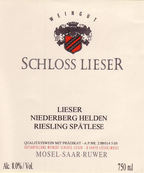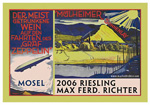Riesling is possibly the most misunderstood grape varietal in the wine world, especially when it comes to American palates. Ask your average wine drinker in the U.S. what they think of Riesling and they'll undoubtedly say it's sweet. In many instances they're right. But Riesling runs the gamut from super-sweet dessert wines to bone-dry bottles that you could even pair with a steak. Riesling, which can show peach, apple and pear notes, pairs with a variety of food from soft cheeses, pork and fish or sushi to spicy Thai dishes and Indian curries and more.
In May, I had a great opportunity to take a trip sponsored by the German Wine Institute to visit German wine-growing regions. Germany has 13 distinct growing regions, with most centered around or near the Rhine river. We spent four full days hitting three of those regions -- Rheinhessen, Pfalz and Mosel -- and learning all about the diversity of the Riesling grape, and let me tell you, it's diverse.
Riesling, like most German wines, are classified by a number of things. With Riesling, the wine can be a kabinett (a more basic wine that tends to be drier), spatlese ("late harvest," and is sweeter), auslese ("select harvest," and even sweeter) and on to beerenauslese (a late harvest dessert wine that tends to be a bit more syrupy and sweet). The quality of the wine and whether it's trocken (dry) or suess (sweet) all depends on where it's grown and how long the grapes remain on the vine. And one of the more impressive qualities of the vineyards, at least in the Mosel region, is that many reside on very steep slopes, giving the grapes better access to sun, wind and other elements that help them grow and produce more robust, juicy fruit.
Although I tried and enjoyed many different types of Riesling, even some Pinot Noir (locally called Spätburgunder) in the three areas, I most enjoyed the wines from the Mosel (you may recognize the former official name of the region as Mosel-Saar-Ruwer, as is printed on many classic German wine bottles). The Mosel is a colder region (where the Pflaz is the warmest and therefore is more accommodating for red wine) and therefore produces very crisp wines with pronounced acidity and brightness.
 All in all, I tasted dozens of wines over the course of the trip from wineries including Gysler (a totally biodynamic winery with a beautiful, modern tasting room and is part of the "Message in a Bottle" association of young wine growers), Fitz-Ritter (Oprah loves their Gewürztraminer, which can be found in Chicago at Bin 36 and Randolph Wine Cellars); Reichsgraf von Kesselstatt (owned by the super classy Annegret Reh-Gartner, who produces award-winning and high-scoring wines that are sold in 25 countries worldwide) and Schloss Lieser, which was possibly my favorite of all. Schloss Lieser
All in all, I tasted dozens of wines over the course of the trip from wineries including Gysler (a totally biodynamic winery with a beautiful, modern tasting room and is part of the "Message in a Bottle" association of young wine growers), Fitz-Ritter (Oprah loves their Gewürztraminer, which can be found in Chicago at Bin 36 and Randolph Wine Cellars); Reichsgraf von Kesselstatt (owned by the super classy Annegret Reh-Gartner, who produces award-winning and high-scoring wines that are sold in 25 countries worldwide) and Schloss Lieser, which was possibly my favorite of all. Schloss Lieser  winery was in disrepair in 1992, but after four years, owner Thomas Haag brought it back to life and now his wines generally get rated between 88 to 98 points by Wine Spectator and the Wine Advocate.
winery was in disrepair in 1992, but after four years, owner Thomas Haag brought it back to life and now his wines generally get rated between 88 to 98 points by Wine Spectator and the Wine Advocate.
One of the biggest disappointments about German wine is that more Americans don't understand and appreciate it. When I went seeking it out around town, I found most wine shops have small selections, reinforcing my theory that most people don't realize Riesling is more than a sweet dessert wine. Ask for the wines above at your favorite shops or check out Truly Fine Wine, a San Diego-based store (with a comprehensive website) that sells only limited-production German wine from micro vintners.
In addition to the wines mentioned above, here are a few more to check out.
Gysler 2006 Weinheimer Riesling Kabinett ($16.99 at Sam's Wines & Spirits). I had the 2008 while at the winery in the Rheinhessen and really enjoyed it, with its touch of sweetness, citrus notes and high acidity. This is a great wine for fresh seafood. If you want a real treat, seek out the Gysler 2005 Huxelbrebe, a beerenauslese dessert wine that sells for $41.99, but when its chilled viscous honey notes slink down your throat after a great meal, you'll be happy you spent the money.
 Max Ferd. Richter 2007 Mulheimer Sonnenlay Riesling "Zeppelin" ($16.99 at Sam's). This winery is one of the older and more respected in the Mosel. All the wines are fermented in oak barrels and are all estate-bottled. This wine features a 1920s art deco label and is a creamy yet sweet wine with gorgeous peach, apple and honey notes. According to winemaker Dirk Richter, it's his best-selling wine in the U.S. market. He also says, "A glass of Riesling a day keeps the doctor away." Who can argue with that?
Max Ferd. Richter 2007 Mulheimer Sonnenlay Riesling "Zeppelin" ($16.99 at Sam's). This winery is one of the older and more respected in the Mosel. All the wines are fermented in oak barrels and are all estate-bottled. This wine features a 1920s art deco label and is a creamy yet sweet wine with gorgeous peach, apple and honey notes. According to winemaker Dirk Richter, it's his best-selling wine in the U.S. market. He also says, "A glass of Riesling a day keeps the doctor away." Who can argue with that?
Zilliken Estate 2007 "Butterfly" Riesling ($16.99 at Wine Discount Center). This is another great example of a Mosel wine: crisp and dry, lots of nice peach notes and a whole bunch of acid and minerals from the slate where the vines grow. This is a great wine to have with any spicy food since the acid will help reduce the heat from overpowering your mouth.